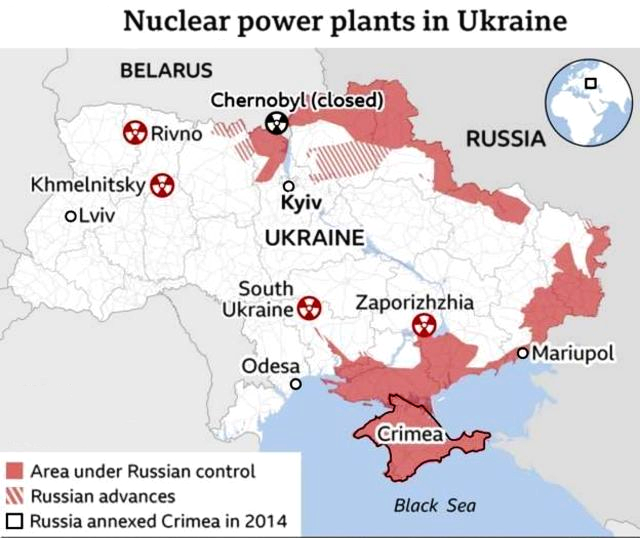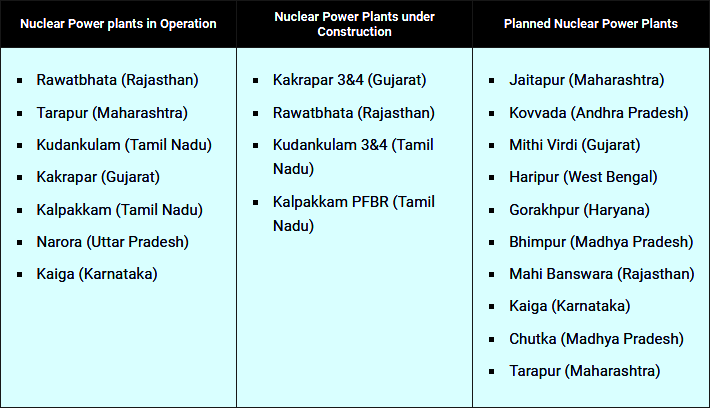Science & Technology
Zaporizhzhia Nuclear Powerplant: Ukraine
- 07 Mar 2022
- 8 min read
For Prelims: Zaporizhzhia Nuclear Powerplant Location, Location of Ukraine.
For Mains: Russia’s war over Ukraine, Nuclear Power Plant in India, Effect of Policies & Politics of Countries on India's Interests.
Why in News?
Recently, Russian forces seized the Zaporizhzhia Nuclear Powerplant, the largest nuclear power plant in Europe.
- The developments at the plant triggered an emergency meeting of the UN Security Council.
Where is the Zaporizhzhia Nuclear Powerplant Located?
- It is located on the banks of the Dnieper river, just 200 kilometers from the conflicted Donbas region where Russian-backed separatists and Ukrainian forces have been fighting.
- Zaporizhzhya is one of the four operating NPPs in the country and has been operating since 1984.
- It accounts for about 40% of the total electricity generated by all the Ukrainian NPPs and one-fifth of Ukraine’s annual electricity production.
- The Zaporizhzhya NPP consists of six Pressurised Water Reactor (PWR) units commissioned between 1984 and 1995, with a gross electrical capacity of 1,000MW each.
PYQ
The function of heavy water in a nuclear reactor is to (2011)
(a) Slow down the speed of neutrons
(b) Increase the speed of neutrons
(c) Cool down the reactor
(d) Stop the nuclear reaction
Ans: (a)
What is a Pressurized Water Reactor?
- It is a type of light water reactor that uses ordinary water as the moderator and coolant.
- The PWR plant is the most common type of nuclear power reactor in the world.
- The Pressurised Heavy Water Reactors (PHWRs) are fuelled by Natural Uranium while Light Water Reactors (LWRs) are fuelled by Low Enriched Uranium.
- A PWR has two water systems:
- One is called the reactor (primary) system that retrieves heat generated in the reactor, and the other is called the turbine (secondary) system that produces electric power with steam generated by that heat.
PYQ
To meet its rapidly growing energy demand, some opine that India should pursue research and development on thorium as the future fuel of nuclear energy. In this context, what advantage, does thorium hold over uranium? (2012)
- Thorium is far more abundant in nature than uranium.
- On the basis of per unit mass of mined mineral, thorium can generate more energy compared to natural uranium.
- Thorium produces less harmful waste compared to uranium.
Which of the statements given above is/are correct?
(a) 1 only
(b) 2 and 3 only
(c) 1 and 3 only
(d) 1, 2 and 3
Ans: (d)
What are the related Concerns?
- Attacks on nuclear power facilities run counter to international humanitarian law, specifically, Article 56 of Additional Protocol I to the Geneva Conventions.
- Additional Protocol I of the Convention: Protection of works and installations containing dangerous forces.
- The Chernobyl disaster in 1986 also is a reminder of why it is vital to ensure all nuclear power plants have the highest standards of safety and security.
What was the Chernobyl Disaster?
- The Chernobyl accident in 1986 was the result of a flawed reactor design that was operated with inadequately trained personnel.
- The resulting steam explosion and fires released at least 5% of the radioactive reactor core into the environment, with the deposition of radioactive materials in many parts of Europe.
- The disaster was a unique event and the only accident in the history of commercial nuclear power where radiation-related fatalities occurred.
- Two Chernobyl plant workers died due to the explosion on the night of the accident, and a further 28 people died within a few weeks as a result of acute radiation syndrome.
- Some 350,000 people were evacuated as a result of the accident, but resettlement of areas from which people were relocated is ongoing.
What about the Nuclear Power Plants in India?
- Nuclear energy is an important component of the country’s energy mix and is being pursued along with other sources of energy in an optimal manner.
- It is a clean, environment friendly base load source of power available 24X7.
- It also has huge potential which can ensure long term energy security of the country in a sustainable manner.
- There are presently 22 reactors with a total capacity of 6780 MW in operation and one reactor, KAPP-3 (700 MW) was connected to the grid in January 2021.
- The Government has accorded administrative approval and financial sanction for construction of 12 nuclear power reactors - 10 indigenous 700 MW Pressurized Heavy Water Reactors (PHWRs) to be set up in fleet mode & 2 units of Light Water Reactors (LWRs) to be set up in cooperation with Russian Federation.
- On progressive completion of the projects under construction and accorded sanction, the nuclear capacity is expected to reach 22480 MW by 2031.
- The Government has also accorded ‘In-Principle’ approval for five new sites for locating nuclear power plants in future.
- In India, some nuclear reactors are kept under “IAEA (International Atomic Energy Agency) safeguards”.
- The nuclear facilities are kept under IAEA)safeguards if the source of Uranium, which is the fissile material for a nuclear reactor, is from outside the territory of India or if the new reactor plants are established with foreign collaboration.
- This is to ensure that imported uranium was not diverted for military use and to assure that the imported uranium is used to generate nuclear energy for civilian purposes.
PYQ
In India, why are some nuclear reactors kept under “IAEA safeguards” while others are not? (2020)
(a) Some use uranium and others use thorium
(b) Some use imported uranium and others use domestic supplies
(c) Some are operated by foreign enterprises and others are operated by domestic enterprises
(d) Some are State-owned and others are privately owned
Ans: (b)








